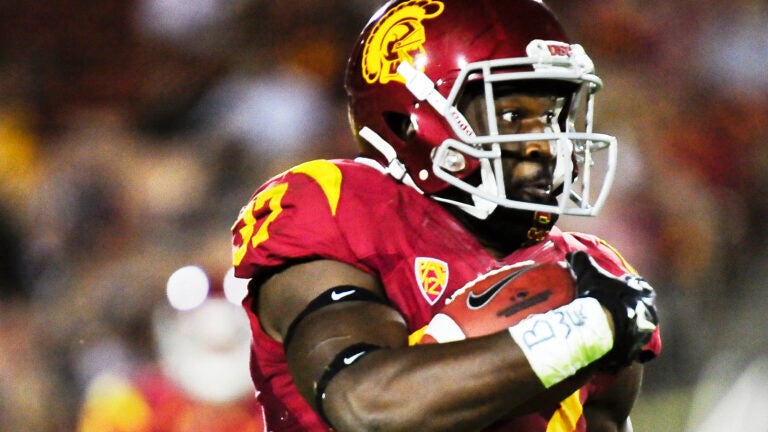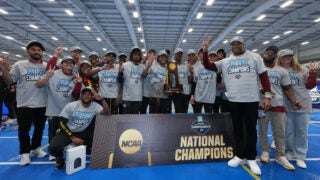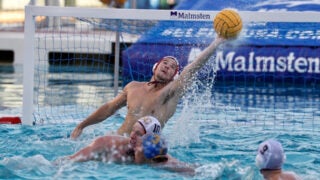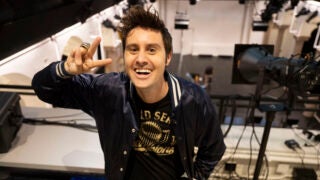
USC football finds an effective way to use GPS technology
A small device tucked under a player’s shoulder pads provides data that can be used to improve training
When USC Trojan football kicks off Saturday against Arkansas State, the players will be sporting a small but important piece of new equipment along with their helmets and mouthguards. A slender GPS device, tucked into a harness underneath their shoulder pads, will be tracking their every movement, providing data that will be used to fine-tune their next training session.
Those small changes could have potentially big ramifications for Trojan football. And it came about thanks to a collaboration between the USC Marshall School of Business and USC Athletics.
Digitize the defense
Julia Plotts, associate professor of clinical finance and business economics at USC Marshall, was leading a group of 50 undergraduate students to Sydney, Australia as part of the school’s Learning About International Commerce (LINC) program in 2009, when the group visited the headquarters of the Sydney Swans, an Australian Football League team.
“Sports are a national obsession in Australia and learning how the Swans approached injury prevention and performance monitoring made me realize how much we could learn from an information exchange in this area,” Plotts said. Among other high-tech tools, the Swans used GPS devices to track players on the field.
Back on campus, Plotts mentioned her observations to USC Marshall Dean James G. Ellis, a passionate Trojan football fan. Ellis promptly connected Plotts with Mark Jackson, then a senior associate director of USC Athletics.
“My eyes were opened about how advanced they were from a technological standpoint,” Jackson said. “As my role at USC grew to include oversight of performance, I wondered how we could take more of a comprehensive look at that.”
Jackson contacted Catapult, the leading maker of sports analytics devices in Australia, and arranged to borrow 17 GPS units to try out on Trojan players in Los Angeles.
The device is a wireless performance-measuring tool that takes complex analytics and presents them as readable data. It gauges everything from players’ performance over time to how quickly they return to play after injury. It sits on top of the athlete’s back, under the jersey, and collects about 1,000 data points per second as the player moves. The raw data go through algorithms that strip out sensor errors and compensate for the force of gravity. The cleaned-up data is sent immediately to a laptop or tablet for interpretation.
“It measures maximum velocity, player load, how much you push out your left foot … everything,” Jackson said. “You have real numbers at the end of every practice,” enabling coaching staff to optimize the information.
As it turns out, optimization was the sticking point.
“It’s one thing to gather a bunch of data,” Jackson noted. “But how do you use it effectively?”
The new moves
GPS technology has become part of the training regimen for elite athletes and pro-level sports teams and their trainers in industrialized countries around the world. Most NFL teams, for example, employ the technology to optimize the training of their athletes.
Not so for college ball, however.
Sports analytics has taken hold on the professional level, but I think we’re at an early stage across the collegiate spectrum.
Courtney Brunious
“There is a cost associated with these analytical processes and the staff that’s needed to go through these details strategically,” says Courtney Brunious, associate director of USC Marshall’s Sports Business Institute. “Sports analytics has taken hold on the professional level, but I think we’re at an early stage across the collegiate spectrum.”
A notable exception: the Florida State Seminoles, who took the national title in 2013 by improving performance and dramatically decreasing player injuries, thanks to the information provided by GPS sports analytics technology.
But first there were two years of trial and error before the team’s data analysts figured out how to best use the data provided by the device.
“It’s an investment in patience more than anything else,” Catapult sports scientist Gary McCoy told ESPN.com.
Plan for recovery
Fortunately for USC, a 27-year-old Australian named Danny van Dijk was on campus working as a strength and conditioning intern.
A former semi-professional rugby player with a bachelor’s degree in physical education and a master’s in exercise science, he took a look at the data that had been collected and saw right away that it could do more.
GPS technology prepares us better to manage our athletes and plan our training week.
Danny van Dijk
“More than anything, GPS technology prepares us better to manage our athletes and plan our training week,” van Dijk said. “We can use it to manage the loads placed upon our guys more effectively and really objectify our return-to-competition protocols.”
Fundamentally, he said, it’s about flow.
“If you want to peak on Saturday, you need to prepare optimally Sunday through Friday.”
Van Dijk gave a presentation to this effect to Jackson and USC Athletics Director Pat Haden.
“We were blown away,” Jackson recalled. “He understood this stuff in ways we hadn’t even imagined.”
It was in effect, the green light. Van Dijk was promptly hired full time, and Jackson packed for his first journey Down Under.
Home to Troy
Plotts had earlier invited Jackson along on her 2015 LINC trip to Sydney, and now the timing seemed perfect.
As students visited Dropbox, Apple and Nestle, Jackson spent the week visiting various sports organizations in Sydney and Melbourne. The Swans opened their doors to him: He met with their president, observed their practice sessions and learned more about their training methods, equipment and even the way they traveled.
Jackson also paid a visit to Catapult, based in Melbourne, and inked a deal to bring its technology home to Troy.
“For the first time, we have real objective data that we can rely on to make decisions, to help coaches evaluate how they practice with their team,” he said.
Jackson is quick to point out the GPS device is not meant to replace hands-on coaching.
“We are very cognizant of not relying on it solely,” he said. “It’s a robust tool for our toolbox.”
Sixteen devices were tested during the Bowl season, and some 60 units are being tested during the summer season. Will GPS technology be a game changer for Trojan football? Jackson says to stay tuned.
In the meantime, he credits Dean Ellis for brokering the critical connections that started it all.
“Jim is a fantastic ambassador for USC Athletics,” he said. “He has always put a welcome mat out for our athletes who are interested in business education.”
Jackson, who was recently named athletic director for Villanova University, said he will be watching the Trojans master their new GPS-led sports analytics from afar.
“I think we’re all playing catch up with this technology, especially at the collegiate level,” he said. “But being Trojans, it won’t be long before we get there.”



